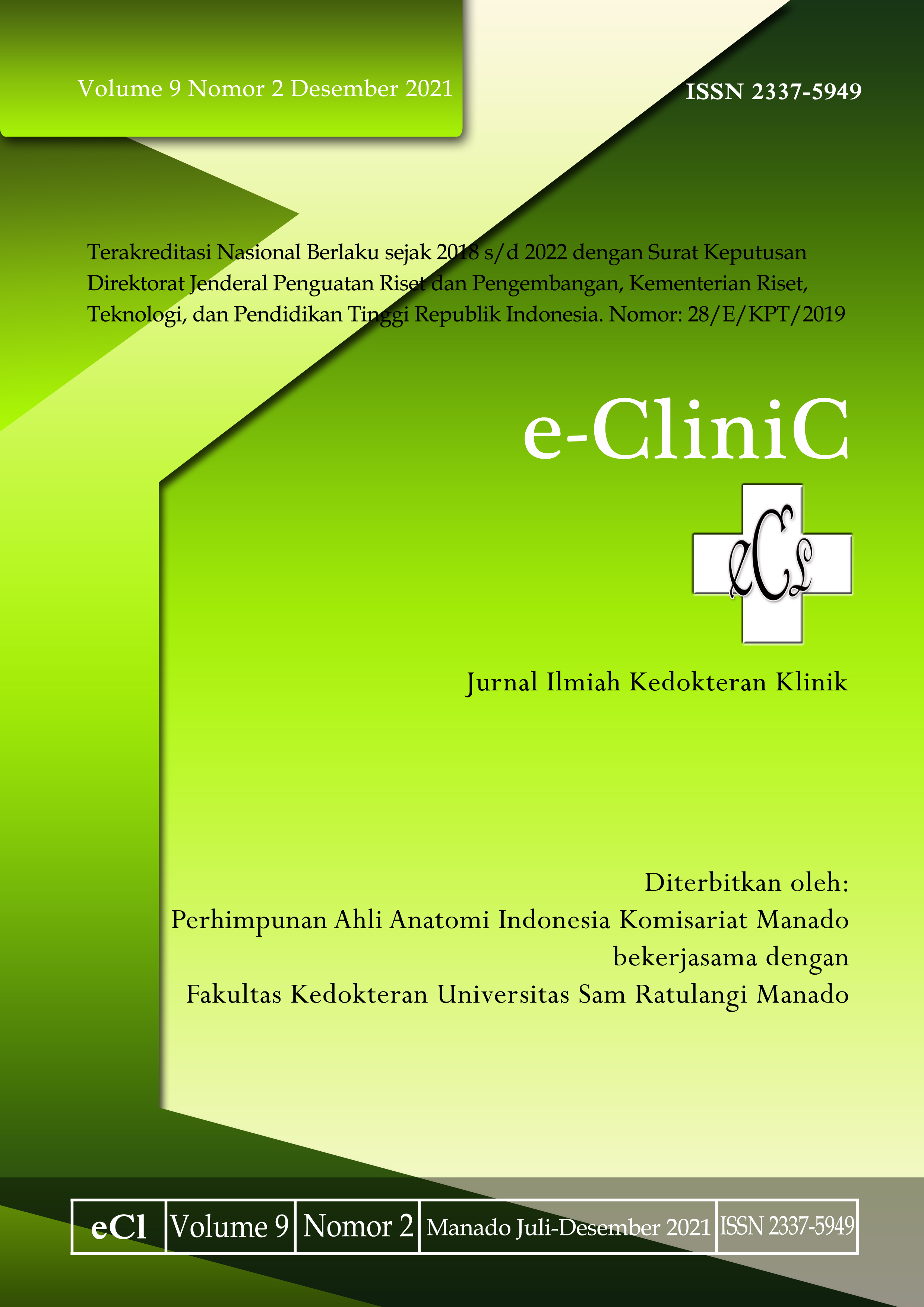Gejala Gastrointestinal pada Pasien COVID-19
DOI:
https://doi.org/10.35790/ecl.v9i2.32851Abstract
Abstract: Patients suffering from corona virus desease of 2019 (COVID-19) could have gastro-intestinal symptoms such as diarrhea, vomiting, and stomach pain. Studies show that human receptor for COVID-19 namely the angiotensin-converting enzyme 2 (ACE2) receptors are also expressed in small intestinal epithelial cells. This study was aimed to determine the gastrointestinal symptoms often found in patients with COVID-19. This was a literature review study using data-bases of Google Scholar, the keywords were (“Covid†AND “gastrointestinal symptomsâ€), and filtering data by time 2019-2020. The results obtained 10 literatures that fulfilled the inclusion and exclusion criteria. The review obtained that viral infection causes changes in intestinal permeability. SARS-CoV was also identified in ileal and terminal colon biopsy. Gastrointestinal symptoms are accompanied by inflammation of the intestines. The highest percentage of gastrointestinal symptoms were anorexia, followed by diarrhea, nausea/vomiting, abdominal pain. Gastrointestinal symptoms could be the first symptoms or even the only symptoms that appeared in Covid-19 patients. Gastrointestinal symptoms were also associated by impaired hepatic function. In conclusion, gastrointestinal symptoms in Covid-19 patients had a relatively high prevalence, and often appeared as anorexia, diarrhea, nausea/vomiting, and abdominal pain. Some of these symptoms were related to the severe course of Covid-19. Impaired liver function also exacerbated these symptoms as well as a marker of a poor clinical course of Covid-19. Â
Keywords: COVID-19, gastrointestinal symptoms                                                                                        Â
Â
Â
Abstrak: Penderita COVID-19 dapat disertai gejala gastrointestinal seperti diare, muntah, dan sakit perut. Studi menunjukkan bahwa reseptor manusia untuk COVID-19 yaitu reseptor angiotensin-converting enzyme 2 (ACE2) diekspresikan juga dalam sel epitel usus kecil. Penelitian ini bertujuan untuk mengetahui gejala gastrointestinal yang sering ditemukan pada pasien dengan COVID-19. Jenis penelitian ialah literature review yang menggunakan database Google Cendekia, dan kata kunci (“Covid†DAN “gejala gastrointestinalâ€) dengan filter rentang waktu tahun 2019-2020 Hasil penelitian mendapatkan 10 literatur yang memenuhi kriteria inklusi dan eksklusi penelitian. Kajian mendapatkan infeksi virus menyebabkan perubahan permeabilitas usus. SARS-CoV juga diidentifikasi pada biopsi ileum dan kolon terminal. Masalah usus dikaitkan dengan tingkat keparahan infeksi. Gejala gastrointestinal disertai dengan peradangan atau kerusakan usus. Beberapa penelitian menunjukkan persentase gejala gastrointestinal tertinggi ialah anoreksia, diikuti diare, mual/muntah, dan terakhir nyeri perut. Juga disebutkan bahwa gejala gastrointestinal dapat merupakan yang pertama muncul atau bahkan satu-satunya gejala pada pasien Covid-19. Gejala gastrointestinal juga dikaitkan dengan gangguan fungsi hati. Simpulan penelitian ini ialah gejala gastrointestinal pada pasien Covid-19 memiliki prevalensi yang relatif tinggi dan sering berupa anoreksia, diare, mual/muntah, dan nyeri perut. Beberapa gejala tersebut berhubungan dengan perjalanan Covid-19 yang berat. Gangguan fungsi hati juga turut memper-berat gejala tersebut sekaligus menjadi penanda perjalanan klinis yang buruk dari Covid-19.
Kata kunci: Â COVID-19, gejala gastrointestinal
Downloads
Published
How to Cite
Issue
Section
License
COPYRIGHT
Authors who publish with this journal agree to the following terms:
Authors hold their copyright and grant this journal the privilege of first publication, with the work simultaneously licensed under a Creative Commons Attribution License that permits others to impart the work with an acknowledgment of the work's origin and initial publication by this journal.
Authors can enter into separate or additional contractual arrangements for the non-exclusive distribution of the journal's published version of the work (for example, post it to an institutional repository or publish it in a book), with an acknowledgment of its underlying publication in this journal.
Authors are permitted and encouraged to post their work online (for example, in institutional repositories or on their website) as it can lead to productive exchanges, as well as earlier and greater citation of the published work (See The Effect of Open Access).







